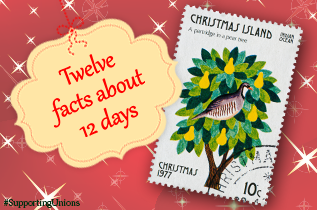1) The song was first published in England in 1780, but it's thought to be of French origin.
2) The tune now used to accompany it is derived from a 1909 arrangement of a traditional folk melody by English composer Frederic Austin. He was the guy who first introduced the now familiar prolongation of the verse "five gold rings".
3) The twelve days described in the song start with Christmas Day (or, in some traditions, Boxing Day) and continue to the day before Epiphany, or the Feast of Epiphany itself (January 6th).
4) It is believed the song was intended as a "memories-and-forfeits" game for kids, in which a leader recited a verse, each of the players repeated the verse, the leader added another verse, and so on until one of the players made a mistake and had to perform some kind of forfeit.
5) In the northern counties of England, the song was often called the "Ten Days of Christmas", as there were only ten gifts.
6) In the Faroe Islands, there is a similar Christmas counting song. Here, gifts include: one feather, two geese, three sides of meat, four sheep, five cows, six oxen, seven dishes, eight ponies, nine banners, ten barrels, eleven goats, twelve men, thirteen hides, fourteen rounds of cheese and fifteen deer.
7) Meanwhile, an Australian variation sees the traditional gifts replaced with native Australian animals.
8) Alvin and the Chipmunks covered the song for their 1963 album Christmas with The Chipmunks, Vol. 2.
9) Since 1984, the costs of the items referenced in the song have been used as a tongue-in-cheek economic indicator.
10) The song has been covered by US comedienne Fay McKay - with an alcoholic twist. In her rendition, "The Twelve Daze of Christmas", the gifts were replaced with various types of booze, with her performance sounding increasingly drunk as the song progressed.
11) Some people believe the song is Catholic catechism originating in post-Reformation England. In this reading, the gifts become codes for basic tenets of the faith, including four calling birds as the four gospels and the pipers piping as the eleven faithful apostles.
12) Rather than referring to jewellery, it is widely thought that the "five gold rings" of the song are actually describing the yellowish rings around a pheasant’s neck or to "goldspinks," an old name for the Goldfinch.








